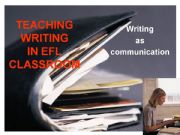
TEACHING �WRITING �IN EFL �CLASSROOM Writing as communication
Types of writing
Writing can be expressive, poetic, informative and persuasive.
Depending on the type of writing, the writer concentrates either on the subject matter of the written piece, or on the reader, or on one�s own feelings and thoughts.
The triangle of the �subject matter�, �writer� ...
Level: advanced
Age: 17-100
Downloads: 48
|
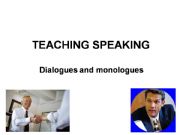
TEACHING SPEAKING Dialogues and monologues
Teaching dialogue is based on psycholinguistic nature of speech generation (production) and speech reception
A speech stimulus requires use of real communicative situations or invention of an imaginative one
Programming an utterance that includes the stage of structural analysis of the situation a...
Level: advanced
Age: 15-100
Downloads: 27
|
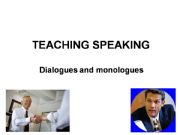
TEACHING SPEAKING Dialogues and monologues
Teaching dialogue means arranging a series of training exercises to master all of its possible components � lexical and grammatical models typical of real-life communication � and to train communicative reactions to what is heard
Modify and repeat
Learn and repeat
Answer together according to the...
Level: advanced
Age: 17-100
Downloads: 40
|
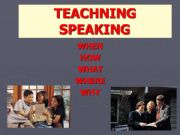
TEACHNING SPEAKING
Several approaches to identifying speaking content
1) topics to discuss
2) real-life communicative situations
3) modelling the communicative process
Which of these is the most adequate form for the content of communication?
Knowledge of the world and reality is stored in the human consciousne...
Level: advanced
Age: 18-100
Downloads: 73
|
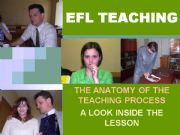
THE ANATOMY OF THE TEACHING PROCESS A LOOK INSIDE THE LESSON
Beginning � 400 words, BGS, BP, EVDT/S
Pre-Intermediate � 800-1000 words, BGS, EVDT/S
Intermediate � 1000-1500 words, CGS, MT/S
Upper-Intermediate � 1500-2000 words, CGS, MT/S
Advanced � 2000-2500 words, All GS, WET/S
Proficiency � more than 3000 words, All GS, AT/S
Sequencing and interrelat...
Level: advanced
Age: 14-17
Downloads: 47
|
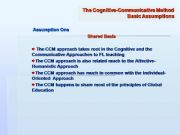
The Cognitive-Communicative Method�Basic Assumptions
Shared Basis
The CCM approach takes root in the Cognitive and the Communicative Approaches to FL teaching
The CCM approach is also related much to the Affective-Humanistic Approach
The CCM approach has much in common with the Individual-Oriented Approach
The CCM happens to share most of the...
Level: advanced
Age: 14-17
Downloads: 16
|
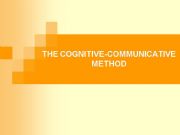
THE COGNITIVE-COMMUNICATIVE METHOD
A complex functional skill as a hierarchy of components
The teacher can draw a workable chart of functional skill components to keep track of them and to set a complex skill into motion as early as possible.
Such a chart will indicate where different functional skills overlap.
It is evident th...
Level: advanced
Age: 14-17
Downloads: 22
|
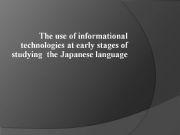
The use of informational technologies at early stages of studying the Japanese language
The use of informational technologies at early stages of studying the Japanese language
Level: advanced
Age: 14-17
Downloads: 1
|
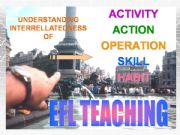
UNDERSTANDING INTERRELLATEDNESS OF ACTIVITY ACTION OPERATION SKILL HABIT
TEACHER MUST UNDERSTAND AND KNOW
how students remember and interpret rules and functions of language items
how to teach students to understand and use LI in oral and written communication
how to encourage conscious self-control of one�s speech activity
TEACHER MUST RELY ON
basic principles of s...
Level: advanced
Age: 14-17
Downloads: 22
|

What audiovisuals and technical devices should be used in EFL teaching?�
audiovisuals and technical devices in EFL teaching
Level: advanced
Age: 14-17
Downloads: 19
|